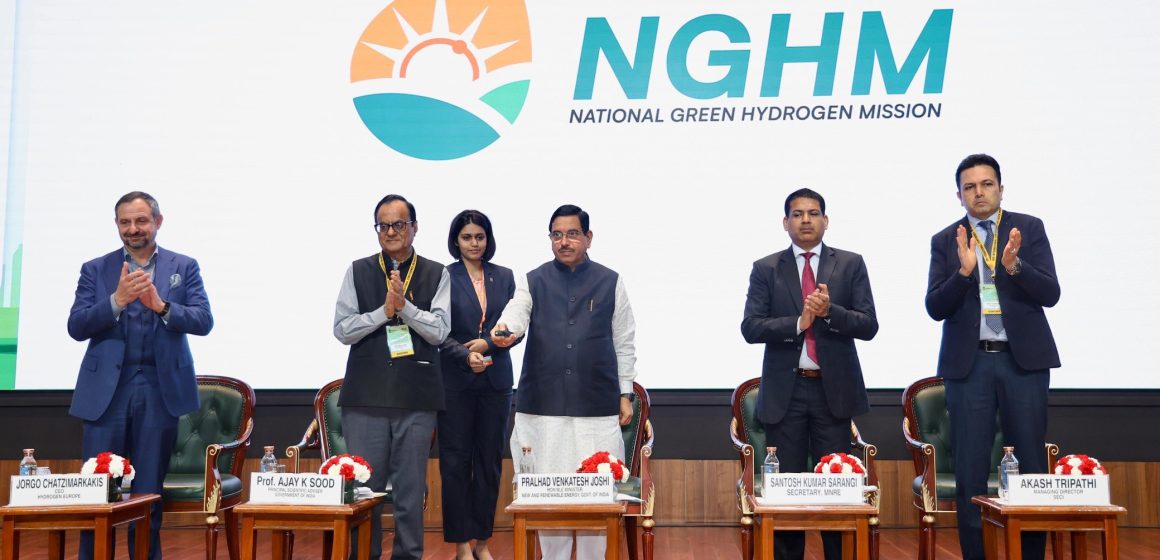To fast‑track innovation, the Minister for New and Renewable Energy announced a renewed ₹100 million call for pilot projects in advanced hydrogen technologies, including biomass‑based solutions.
Union Minister for New and Renewable Energy Pralhad Venkatesh Joshi has said that with the world adopting the Carbon Border Adjustment Mechanism (CBAM), adoption of green hydrogen is no longer an option but an economic necessity, urging the industry to gear up for the ensuing transformation.
Inaugurating the 3rd International Conference on Green Hydrogen in New Delhi on Tuesday, Joshi declared, “Global economies are moving towards cleaner value chains, and those who adopt early will lead the markets of tomorrow. Our industry and economy must make a shift towards sustainability.”
The EU’s CBAM, introduced in October 2023, will fully take effect in January 2026 after a transition period. It puts a carbon price on imports like steel, cement, aluminium, fertilisers, and electricity, so that foreign producers face the same costs as EU companies under its emissions trading system.
Noting that India’s growth remains both competitive and climate‑resilient, he said the country was striving to power its entire green hydrogen production using one of the world’s lowest‑cost renewable energy bases.
“With rapidly expanding wind and hydro projects, we are building the clean energy base that will drive the next great industrial revolution; the hydrogen revolution.”
Joshi said that the National Green Hydrogen Mission (NGHM), launched in 2023, specifically targets carbon‑intensive sectors such as energy, steel, transport, and shipping.
“Under NGHM, we aim to make India a global hub for green hydrogen production, use, and export.”
With a ₹19.744 billion ($2.2 billion) allocation, NGHM targets 5 million metric tonnes (MMT) of green hydrogen production by 2030, 125 GW renewable energy capacity, ₹8 trillion in investments, 6 million green jobs, and a ₹1 trillion reduction in fossil fuel imports. It also seeks to cut down 50 million tonnes (MT) of carbon dioxide emissions annually.
Citing forecasts by global agencies, Joshi also outlined India’s long‑term strategy on the commodity.
“India aims to capture at least 10 per cent of the green hydrogen demand, making us not only an aatmanirbhar (self‑reliant) producer but also a major exporter of green hydrogen and its derivatives.”
According to the International Renewable Energy Agency (IRENA) and the World Trade Organisation (WTO), renewable hydrogen and its derivatives are expected to meet up to 14 per cent of global energy demand by 2050. The Hydrogen Council further estimates that 190 MT of hydrogen equivalent will be traded internationally by that time.
Policy Incentives
Joshi said that since the mission’s launch, India has made remarkable progress. Incentives have been awarded for around 3000 MW per annum of domestic electrolyser manufacturing capacity and for 8.62 MMT of green hydrogen production. The country now has the lowest green ammonia price globally at $5.6 per kg for 7.4 MMT per annum.
To accelerate innovation, he announced a fresh call for pilot projects showcasing cutting‑edge technologies, including biomass-based hydrogen.
“A total of ₹100 million has been earmarked, supplementing ₹100 million previously allocated to startups. The implementing agency, BIRAC (Biotechnology Industry Research Assistance Council), will shortly release the call for proposals,” he added.
He said these technical initiatives are moving alongside workforce skilling, with the National Council for Vocational Education and Training approving 43 qualifications, with over 6,300 trainees already certified. The green hydrogen standard was notified in August 2023, followed by the launch of green hydrogen certifications in April 2025.
“The R&D roadmap released in October 2023 has already led to 23 funded projects worth ₹115 million. Five major testing facilities are being funded with ₹114 million, and 128 standards have been published by national agencies to ensure safety and interoperability.”
To facilitate the ease of doing business, Joshi said the National Single Window Portal for Green Hydrogen and electrolyser manufacturing had been launched, with Gujarat, Kerala, and Rajasthan already on board. He also mentioned other projects launched, including ₹132 million for green steel pilots, 37 hydrogen‑fuelled vehicles and nine refuelling stations supported with ₹208 million, and ₹35 million sanctioned for India’s first hydrogen bunkering and refuelling facility at VO Chidambaranar Port. Four hydrogen valley innovation clusters are being developed with a ₹170 million outlay.
“We have waived all ISTS (Inter‑State Transmission System) charges for green hydrogen projects commissioned before December 2030. Green hydrogen and green ammonia plants have been exempted from environmental clearances, and Kandla, Paradip, and Tuticorin ports have been identified as dedicated green hydrogen hubs.”
Earlier in the day, Joshi unveiled the new National Green Hydrogen Mission (NGHM) logo, which was selected from among 2,500 entries. The logo represents India’s green hydrogen ambition, self‑reliance, and the mission’s multi‑sector potential.
– Manish Pant


